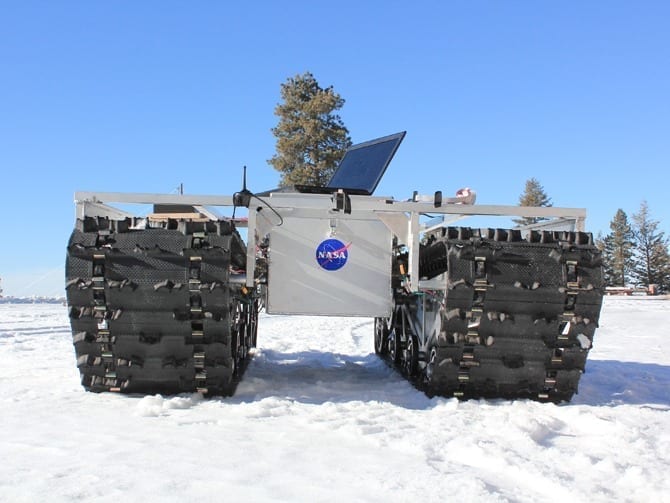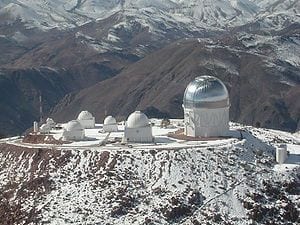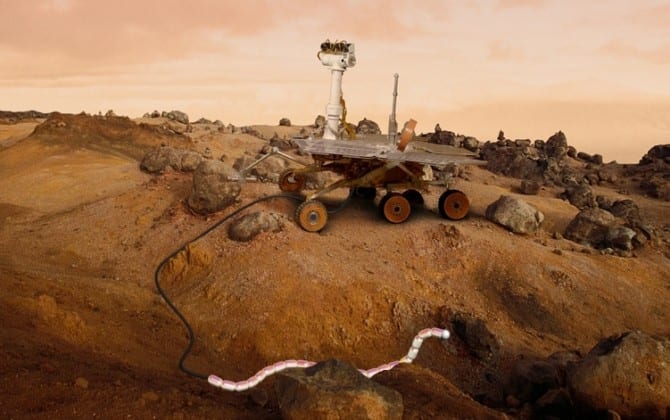
NASA’s newest scientific rover is set for testing May 3 through June 8 in the highest part of Greenland.
The robot known as GROVER, which stands for both Greenland Rover and Goddard Remotely Operated Vehicle for Exploration and Research, will roam the frigid landscape collecting measurements to help scientists better understand changes in the massive ice sheet.
This autonomous, solar-powered robot carries a ground-penetrating radar to study how snow accumulates, adding layer upon layer to the ice sheet over time.
Greenland’s surface layer vaulted into the news in summer 2012 when higher than normal temperatures caused surface melting across about 97 percent of the ice sheet. Scientists at NASA’s Goddard Space Flight Center in Greenbelt, Md., expect GROVER to detect the layer of the ice sheet that formed in the aftermath of that extreme melt event.
Research with polar rovers costs less than aircraft or satellites, the usual platforms.
“Robots like GROVER will give us a new tool for glaciology studies,” said Lora Koenig, a glaciologist at Goddard and science advisor on the project.
GROVER will be joined on the ice sheet in June by another robot, named Cool Robot, developed at Dartmouth College, Hanover, N.H., with funding from the National Science Foundation. This rover can tow a variety of instrument packages to conduct glaciological and atmospheric sampling studies.
GROVER was developed in 2010 and 2011 by teams of students participating in summer engineering boot camps at Goddard. The students were interested in building a rover and approached Koenig about whether a rover could aid her studies of snow accumulation on ice sheets. This information typically is gathered by radars carried on snowmobiles and airplanes. Koenig suggested putting a radar on a rover for this work.
Koenig, now a science adviser on the GROVER Project, asked Hans-Peter Marshall, a glaciologist at Boise State University to bring in his expertise in small, low-power, autonomous radars that could be mounted on GROVER. Since its inception at the boot camp, GROVER has been fine-tuned, with NASA funding, at Boise State.
The tank-like GROVER prototype stands six feet tall, including its solar panels. It weighs about 800 pounds and traverses the ice on two repurposed snowmobile tracks. The robot is powered entirely by solar energy, so it can operate in pristine polar environments without adding to air pollution. The panels are mounted in an inverted V, allowing them to collect energy from the sun and sunlight reflected off the ice sheet.
A ground-penetrating radar powered by two rechargeable batteries rests on the back of the rover. The radar sends radio wave pulses into the ice sheet, and the waves bounce off buried features, informing researchers about the characteristics of the snow and ice layers.
From a research station operated by the National Science Foundation called Summit Camp, a spot where the ice sheet is about 2 miles thick, GROVER will crawl at an average speed of 1.2 mph (2 kilometers per hour). Because the sun never dips below the horizon during the Arctic summer, GROVER can work at any time during the day and should be able to work longer and gather more data than a human on a snowmobile.
The Latest Bing News on:
NASA Rover
- NASA VIPER Moon Rover Prototype Rolls Down Ramp In Tests On Earthon May 8, 2024 at 7:30 am
Watch a prototype of NASA's Volatiles Investigating Polar Exploration Rover, (VIPER) roll down a ramp to simulate its deployment on the lunar surface. Credit: NASA ...
- NASA’s Curiosity Rover Uncovers Signs of an Earth-Like Environment on Ancient Marson May 4, 2024 at 1:16 am
Manganese-rich sandstones discovered by NASA’s Curiosity rover indicate there were once habitable conditions in the Gale Crater on Mars. A research team using the ChemCam instrument onboard NASA’s Cur ...
- Mars Loaded With Mineral Closely Associated With Life, NASA Rover Findson May 2, 2024 at 1:00 pm
Oxidation Fascination NASA's Curiosity Mars rover has discovered rocky material that is riddled with an unusual amount of manganese, a mineral that's abundant in lakes found back on Earth. It's yet ...
- Ancient Mars 'Surprisingly' Like Earth, NASA Rover Revealson May 2, 2024 at 5:23 am
Manganese was found in an ancient Mars lakebed, suggesting that the environment could have been highly useful to lifeforms.
- This Rover Plans To Search For Life On Mars: Here's Howon May 1, 2024 at 1:15 pm
Mars has seen some traffic in recent years with NASA's Curiosity and Perseverance rovers and China's Zhurong rover exploring the red planet. Soon, another rover will be joining the Mars exploration ...
- NASA prepares for intense sun storms on Mars during 'solar maximum'on May 1, 2024 at 12:00 pm
"I'd actually love to see the 'big one' at Mars this year — a large event that we can study to understand solar radiation better before astronauts go to Mars." ...
- NASA announces Rover Challenge winnerson May 1, 2024 at 12:00 am
NASA announced the winners of the 30th Human Exploration Rover Challenge April 22, with Parish Episcopal School, from Dallas, winning first place in the high school division, and the University ...
- NASA's Mars Sample Return mission is in trouble—but it's a vital step to sending humans to the red planeton April 30, 2024 at 10:01 am
NASA recently asked the scientific community to help come up with innovative ideas for ways to carry out its Mars Sample Return (MSR) mission. This was in response to a report by an independent board ...
- NASA's Viper moon rover gets its 'neck' and 'head' installed for mission later this yearon April 29, 2024 at 2:01 pm
NASA''s Volatiles Investigating Polar Exploration Rover (VIPER) has earned its "neck" and "head," aka its "mast," meaning it now stands proudly at 8 feet (2.4 meters) tall.
- A NASA rover has reached a promising place to search for fossilized life on Marson April 24, 2024 at 12:38 pm
While we go about our daily lives on Earth, a nuclear-powered robot the size of a small car is trundling around Mars looking for fossils. Unlike its predecessor Curiosity, NASA's Perseverance rover is ...
The Latest Google Headlines on:
NASA Rover
[google_news title=”” keyword=”NASA Rover” num_posts=”10″ blurb_length=”0″ show_thumb=”left”]
The Latest Bing News on:
Autonomous solar-powered robot
- New solar farm strengthens University of York’s autonomous research capabilitieson May 8, 2024 at 5:27 am
Work on the 200kWp solar farm located at the University of York’s new Institute for Safe Autonomy was completed by Siemens.
- Sea drone warfare has arrived, but the US is flounderingon May 6, 2024 at 2:34 pm
The U.S. Navy's efforts to build a fleet of unmanned vessels are faltering because the Pentagon remains wedded to big shipbuilding projects, exposing a weakness as sea drones reshape naval warfare.
- Insight: Sea drone warfare has arrived. The U.S. is floundering.on May 6, 2024 at 8:50 am
The U.S. Navy's efforts to build a fleet of unmanned vessels are faltering because the Pentagon remains wedded to big shipbuilding projects, according to some officials and company executives, ...
- Could Autonomous Trucks Help Save the Planet?on May 3, 2024 at 1:00 pm
It's understood that autonomous trucks boost fuel efficiency compared to human-driven big rigs. But the potential energy efficiency gains could be far greater.
- Mobile roboton May 1, 2024 at 5:00 pm
The Acorn is a newly-open-sourced robot from Twisted Fields ... instead it’s an autonomous solar-powered rover intended for larger farms which will cruise the fields continuously tending ...
- How do robot lawn mowers work?on April 30, 2024 at 1:10 am
If you're wondering how robot lawn mowers work, if they work and whether they’re actually worth it, we have you covered ...
- Technology provider announces robotics system to keep solar panels at peak performance — here's how it workson April 21, 2024 at 3:30 am
This technology could make it easier for homeowners to keep their panels spotless. Technology provider announces robotics system to keep solar panels at peak performance — here's how it works first ...
- This solar-building robot is designed to solve one of the industry’s biggest problemson April 18, 2024 at 5:00 pm
Hunter, who’d previously worked at a startup making a surgical robot, had decided to transition to working on a climate solution. Before focusing on solar power, he partnered with Max Justicz ...
- Do Your Solar Panels Work At Night And When It's Cloudy?on April 8, 2024 at 7:15 am
Solar power is the cleanest ... installations around the world is robot solar panel cleaners that remove dust and dirt to increase efficiency. These autonomous machines work at night to reduce ...
- This Autonomous Robot Can Build Solar Farms 3-5 Times Faster Than Human Crewson May 10, 2023 at 2:27 am
What if a giant autonomous robot could construct structures faster ... governments around the world are increasingly pushing solar power as a viable alternative. The RPD 35, created by Built ...
The Latest Google Headlines on:
Autonomous solar-powered robot
[google_news title=”” keyword=”autonomous solar-powered robot” num_posts=”10″ blurb_length=”0″ show_thumb=”left”]










